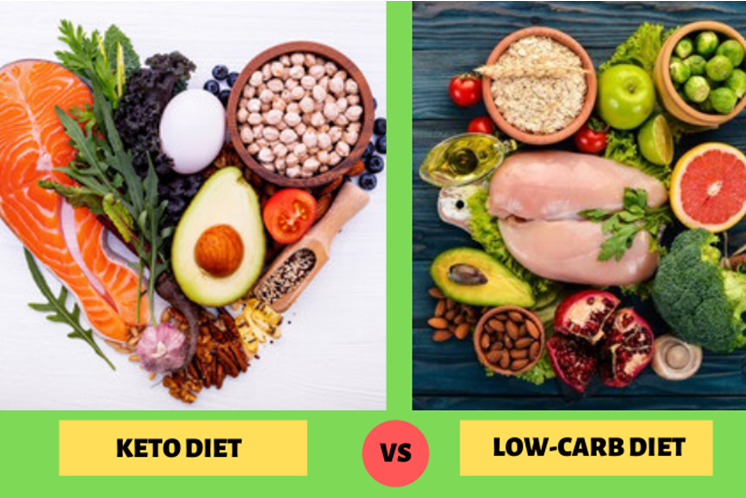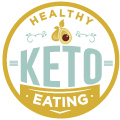Keto Plan Vs Low Carb Diet

There are so many debates on Keto diets vs low carb diets. Yes, everyone’s needs are different, we can determine what’s right for us by using the Body Weight Planner, from the National Institute of Health.
Let’s take a look at the differences between keto and low-carb diet and when you might try one over the other.
The Basics of Keto Diet: The current literature supports the effectiveness of low carb diets for weight loss and health improvement.
The Keto diet is about a low-carb diet as we can go. As the usual rule, a Keto diet typically has:
- 65-80% Fat
- 15-25% Protein
- 5-10% Carbs
While a low-carb diet may not have any specific rules to follow, a Keto diet is defined by staying in a specific metabolic state called Ketosis. To stay in Ketosis, it’s required to eat net carbs which are usually 20 grams a day.
Keto is great for-
- Weight loss
- Stable energy and blood sugar
- Decreasing inflammation
- Endurance athletes and many more.
People should be strict about carb intake on Keto because if they eat too many carbs, their metabolism will switch off fat burning and then they go back to using those carbs as fuel. Everyone has their specific and unique needs; therefore, you need to find out their ideal macro values that are the key to success.
The Basics of Low-Carb Diet: There are no official guidelines for the low-carb diet. The low-carb diet is basically Keto. But with slightly higher carb intake that maybe 50 -120g of carbs in a day.
Most low-carb diets focus on food quality and cutting out high-carb refined foods like bread, sugar, soda, pasta, high-fructose corn syrup, baked goods, pastry etc. Even strict low-carb diets may cut other carbs like fruits.
Low-carb diet is great for-
- Non-endurance athletes.
- Stable energy and blood sugar.
- Being more relaxed with diet.
Due to the simple concept, a low-carb diet can be approached in different ways like Paleo, Mediterranean and Atkins diets. Low-carb diets aren’t usually low enough in carbs to keep the body in full ketosis. This diet doesn’t define a set number of carbs to stay under each day based on the body’s needs or goals. It gives us room to adjust our diet and find the carb intake that makes us feel best.
Some people may do better with low-carb while others may do better with Keto. We should follow which diet depends on your goals, preferences, lifestyle and unique biology.
Reasons For Not Losing Weight On The Keto Eating Plan

The Keto Eating Plan has been recommended as a major weight loss program. Keto has changed some people’s bodies in stunning ways. It’s a low-carb way of eating that has been used by many looking to lose weight and improve health. During a Keto Eating Plan, carbs are typically reduced to around 20 grams per day. Thus, it has been shown to lead to weight loss, however, to acquire the benefits of the Keto Eating Plan, it must be implemented correctly.
Here are some reasons you are not losing weight on Keto.
Reason # 1- Eating Too Many Carbs: On the Keto Eating Plan, you are eating more fat and lowering carb intake. This makes your body burn stored fat for energy. To lose weight on the Keto Eating Plan, you must watch your Carb intake. One of the main reasons people don’t lose weight on Keto is that people consume too many carbs. For losing weight on this diet, carb intake must be around 20 grams per day to enable the state of Ketosis and therefore fat burning.
Reason # 2- Eating Less Nutritious Foods: The key to healthy weight loss is to consume nutritious foods, no matter what dietary plan you follow. So, while you may think you are making great steps toward your weight loss goals by eating significantly less, your body needs the right amount of high-quality food with the right proportions to get to a healthy weight.
Reason # 3 – Not being careful With Dairy: Sometimes eating a lot of dairy foods can take you out of Ketosis. Certain dairy products such as flavored yogurt and 2% milk contain a surprising amount of carbohydrates.
Reason # 4 – An Undiagnosed Medical Issue: The Keto Eating Plan is an effective weight loss plan. However, it’s a good idea to rule out any medical issues that may prevent your weight loss success. Depression, Hypothyroidism, Polycystic ovarian syndrome, and Hyperinsulinemia are medical issues that can cause weight gain and make it very difficult to lose weight.
Reason # 5 – Stressed Out: Researchers show that stress, especially chronic stress, can negatively impact weight loss. Those who are chronically stressed are often sleep deprived, which has also been linked to weight gain.
Reason # 6 – Less Physical Activity: Integrating more physical activity into your lifestyle is vital when trying to lose weight on a Keto Eating Plan. Physical activity burns calories but also helps build muscle, which gives your metabolism a boost by increasing the amount of energy burned at rest.
Reason # 7 – Eating Too Much Protein: The Keto Eating Plan is not a high-protein diet. It’s a moderate protein diet in which about 20% of your calories come from protein. Too much protein can kick you out of Ketosis.
There are many reasons that negatively impact weight loss. The Keto Eating Plan can be an effective weight-loss tool along with other healthy lifestyle changes.
Keto Meal Plan

Keto Eating is a low-carb plan that’s moderate in protein and high in fat. Keto eating means limiting net carb intake to 20 grams per day.
If anyone is looking to maximize benefits like reversing type 2 diabetes or if they have a lot of weight to lose, the Keto Eating plan may be right for them.
Easy Keto Cooking Tips:
- Automate Breakfast: Choose the same Keto breakfast for everyday eating. Such as Scrambled Eggs and Bacon. You can always switch to other Breakfasts if you want. If you’re into Coffee this is fine on the Keto Plan!
- Simply prepare 2 Meals: Cook two servings for dinner and refrigerate the second serving for the next day’s lunch.
- Try No-Cook Plates: Sliced deli meats, veggies, cheese and make an easy lunch.
Foods to Eat:
When following Keto, you need to eat the delicious foods below:
|
Eggs |
Whole eggs |
|
Poultry |
Turkey, Chicken |
|
Oily Fish |
Wild-caught Salmon, Mackerel, Herring, Tuna |
|
Meat |
Grass-fed Beef, Pork, Venison, Organ meats, Bison |
|
Full-Fat Dairy |
Yogurt, Cream, Butter |
|
Full- Fat Cheese |
Cheddar, Brie, Mozzarella, Goat Cheese, Cream Cheese |
|
Nuts and Seeds |
Macadamia Nuts, Almonds, Walnuts, Pumpkin Seeds, Flaxseeds, Peanuts |
|
Nut butter |
Natural Peanut, Cashew butters, Almond |
|
Healthy Fats |
Olive Oil, Avocado Oil, Coconut Butter, Sesame oil, Coconut Oil |
|
Avocados |
Large proportions can be eaten for snacks or meals |
|
Non-starchy vegetables |
Greens, Broccoli, Tomatoes, Peppers, Mushrooms |
Foods to avoid:
You need to avoid foods rich in carbs while Keto Eating. The following foods should be avoided:
- Bread and Baked Goods: White bread, Crackers, Cookies, Whole-wheat bread, Doughnuts, and Rolls.
- Sweetened Beverages: Soda, Sweetened teas, Juice, and Sports Drinks.
- Sweets and Sugary Foods: Sugar, Candy, Ice cream, Maple syrup, and Coconut Sugar.
- Pasta: Noodles and Spaghetti.
- Grains and Grain Products: Wheat, Rice, Oats, Tortillas and Breakfast Cereals.
- Starchy Vegetables: Potatoes, Sweet Potatoes, Butternut Squash, Peas, Corn, and Pumpkin.
- Beans and Legumes: Black beans, Lentils, Chickpeas, and Kidney Beans.
- Fruits: Citrus, Grapes, Pineapple, and Bananas.
- High-carb sauces: Barbecue Sauce, Dipping Sauces and Sugary Salad Dressings
Preparing a shopping list can help us decide what foods will fit in our Keto eating plan. The list will consist of; meat, eggs, poultry, low-carb veggies, full-fat dairy, and healthy fats.
